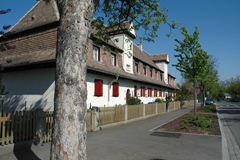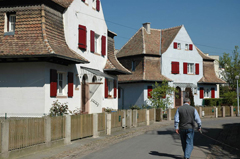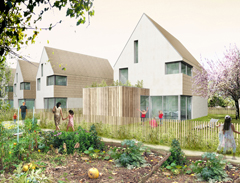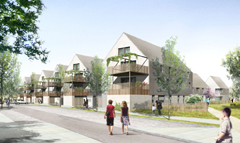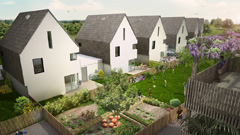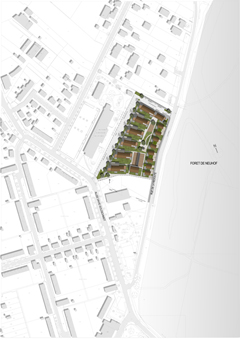Stockfeld Garden City / Cité-jardin du Stockfeld
Exhibit Category / Catégorie de l'expo: City
Location/Emplacement: Strasbourg, France
Dates: 1910 - present
Designers/Concepteurs: Weber & Keiling Architectes; Seyler & Lucan Architectes; Edouard Schimpf (original garden city plan)
Clients: Habitat de l’Ill; SOCOLOPO;
More Information/Plus d'informations:
Image Credits/Crédits d'images: Weber & Keiling Architectes; Seyler Lucan Architectes; Ville de Strasbourg
Project Description: (version française ci-dessous)
The garden city of Stockfeld is one of the first manifestations of this modern and communitarian urban form, theorized by the Englishman Ebenezer Howard in 1902, on the European continent. It was built to accommodate families who were dislocated by major construction projects in the old city centre (particularly the rue du 22 novembre). The garden city model was embraced by Germany to create garden suburbs that seek to improve new residential developments and to address the housing crisis.
The city gave 24 hectares of land to the Cooperative Society for Social Housing (SOCOLOPO), 6 km from downtown. As a result of a competition held in April 1910, the project by the Alsatian architect Edward Schimpf was selected. By the end of 1911, most of the garden city was inhabited. The plan was organized into eleven blocks of 100 x 100 m2. Buildings (providing 457 residences of 45 to 55 m² each) surrounded a large central space divided into vegetable gardens ranging in area between 120 and 150 m². Dirt roads crossed through the orthogonal vegetable gardens in the core of the blocks, linking the secondary paths of the district. Each residence was assigned a vegetable garden, in order to provide a dietary supplement to everyone.
Stockfeld underwent major rehabilitation between 2003 and 2005, including restoration of its vegetable gardens, some of which had been transformed into leisure gardens. In this context, the SOCOLOPO, with Habitat de l’Ill, held a competition in 2010 for a city-owned plot of about one hectare adjacent to the garden city. The aim of this operation was to show that the century-old garden city model is still pertinent and can be revived, given the present-day challenges, new ways of living, and contemporary relations between city and nature. The project has been initiated, for completion in late 2013, to include 19 units of social housing and 36 rent-to-own units.
The master plan adopted by the architects, with a north-south orientation of the dwellings, also helps maintain view corridors towards the heart of each block, arranged as individual garden plots and one shared garden, while maintaining a visual link to the nearby forest. To promote an appropriation of outdoor spaces and a collective lifestyle, a participatory self-management of the gardens has been proposed. Thus, this project links to the core principles of a century earlier as applied to both gardens and dwellings.
Browse for more projects in the Carrot City Index.
Description du Projet:
La cité-jardin du Stockfeld est une des premières manifestations de cette forme urbaine moderne et communautaire, théorisée par l’anglais Ebenezer Howard en 1902, sur le continent européen. Elle fût construite afin de permettre le relogement des familles modestes qui habitaient les immeubles du centre-ville démolis par la Grande Percée (actuelle rue du 22 novembre). Le modèle de cité-jardin fut également adapté en Allemagne (Dresde) pour créer des faubourgs-jardins destinés à améliorer les banlieues et remédier à la crise du logement.
La ville céda un terrain de 24 hectares à la Société coopérative de logements populaires (SOCOLOPO), à 6 km du centre-ville. Suite à un concours, le projet de l’architecte alsacien Edouard Schimpf est retenu en avril 1910. Dès la fin 1911, la majeure partie de la cité est habitée. Le plan est organisé en onze îlots de 100 x 100 mètres de côté. Les habitations (457 logements de 45 à 55 m²) dessinent un vaste espace central découpé en jardins potagers d’une superficie variant entre 120 et 150 m². Des chemins de terre orthogonaux traversent les jardins potagers, au cœur des îlots, reliant les voies secondaires de la cité. Chaque logement se voyait attribuer un jardin potager, qui devait apporter aux habitants un complément alimentaire.
Le Stockfeld a fait l’objet d’un vaste chantier de réhabilitation de 2003 à 2005, y compris la restauration de ses jardins, certains potagers ayant été transformés en jardins d’agrément. Dans ce cadre, la SOCOLOPO, avec Habitat de l’Ill, engagent aussi en 2010 un concours pour un terrain de près d’un hectare adjacent à la cité-jardin, appartenant à la Ville. L’ambition de cette opération est de montrer que le modèle centenaire de la cité-jardin est toujours actuel et peut être renouvelé, au regard des enjeux du 21ème siècle, des nouveaux modes d’habit et des relations contemporaines entre ville et nature. Le projet a été mis en chantier pour une livraison fin 2013, prévoyant la réalisation de 19 logements sociaux et de 36 logements en accession sociale à la propriété.
Le plan masse retenu par les architectes, favorisant les orientations nord-sud des logements, permet également de maintenir des percées visuelles vers le coeur d’îlot, aménagé en jardins potagers individuels et un jardin partagé commun, et de maintenir un lien visuel à avec la forêt voisine de l’opération. Pour favoriser une appropriation des espaces extérieurs et le vivre ensemble au sein de la copropriété, l’autogestion d’un jardin participatif par les copropriétaires est proposée. Ainsi, ce projet renouvèle des principes vieux d’un siècle dans le domaine du jardins comme dans celui de l’habitat.
Trouvez d’autres projets avec l’Index de Carrot City.

